Steeped in ancient and enduring tradition, there is an undeniable mystique attached to trout fishing; in many respects deservedly so.
It is a sport that has been practiced by king and commoner, slave and settler, indigenous cultures, and those of us in between.
Trout fishing is both art and science. Trout fishing is survival and leisure, frivolous entertainment and deeply serious.
If we strip it back of all of its historical baggage, trout fishing is pure unadulterated fun in all of its forms. It’s fun – like…heaps of fun.
Despite a strong historical association with the landed gentry, a continuing litany of rules and compliances; and despite so many trout fishing techniques bordering on the esoteric, trout fishing really is for everybody.
In this article, we’ll be focusing on fishing for stocked trout in the lakes dams and impoundments.
One of the barriers presented by trout fishing is that when we think of trout fishing, we think of fly fishing.
Fly fishing is highly specialized with highly specialized equipment and techniques.
A truly wonderful sport and method of fishing, yes, but there is a lengthy education process involved to achieve a level of proficiency.
Sometimes we need to be reminded that there are plenty of places to fish for trout with the tackle we already have in our fishing kits.
Trout fishing is way more accessible than it is often perceived it to be.
Let’s go trout fishing.
Page Contents
Start Trout Fishing Online

Once upon a time, you would have to do a bit of digging – phone calls, a trip to a tackle shop, etc.
Now, a couple of hours on Google will equip you with everything you need to know to find a lake, dam or pond near you stocked with trout.
Further to location, you also find a tremendous amount of local techniques, lure, bait, and rig suggestions as well as suggested seasonal info.
Importantly, local trout fishing compliances will also be readily available in most cases.
An hour or two on Google will quickly turn into many more, such is the volume of information available. Take notes – you’ll need to.
Get in a chat. You may have to sign up to the site to post a question but these chat spaces are invaluable and free. You will find that people are incredibly helpful.
In most circumstances, local trout anglers can’t wait to share their trout insights with prospective visitors.
Keep in mind, it’s this information that can mean the difference between finding fish and catching fish, and coming up empty-handed.
When equipping yourself with the local inside trout gossip, it’s important to consider how you will be fishing.
Do you have a boat, will you be land-based or will you be venturing out on a kayak?
Gather your information with this in mind. Techniques for finding and catching trout will often be specific to the platform from which you will fish.
Choosing Rods and Reels For Trout
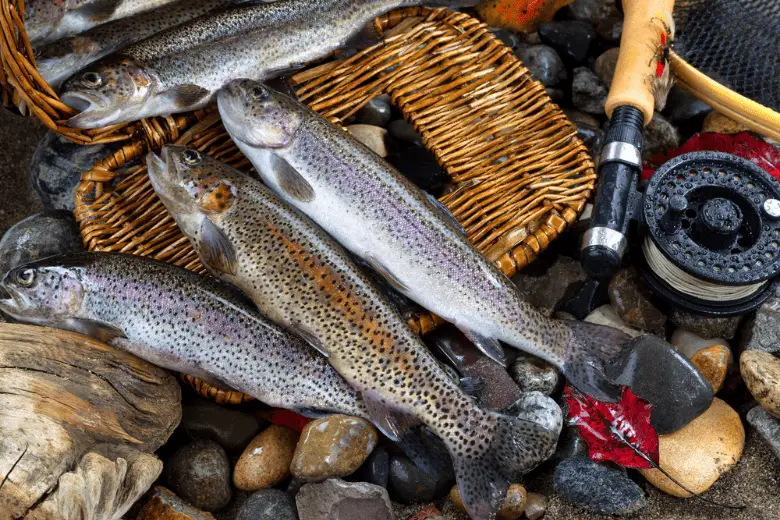
Rigs, rods, and gear will be determined by your location. Are you fishing from a boat or kayak, or are you land based?
Is it a big deep lake? A small pond? Is it accessible to watercraft or are you limited to land-based?
Whatever the case, there is a very good deal of crossover with rod and reel outfits. It’s very much the case that a simple outfit will cover every situation.
In fact, if you have a 7 foot, 2 to 4-kilogram spinning rod matched with a 2000 sized reel, you’re pretty well covered for all three platforms.
Spooled with 6-pound mono or braid, you’re well in business wherever you’re fishing. A soft and sensitive tip is perfect, and a slower action is advised.
Of course, you can refine a trout fishing outfit to perfectly suit an application. For example, a land based angler may want a little more length in a rod.
If you’re trolling, you might want a rod that’s a little stiffer.
You may even find yourself in a location where there are big fish. On a recent trip to Tasmania Australia, me and my kids were fishing Lake Barrington for trout.
I had an outfit identical to the one above that turned out to be underpowered when I hooked an Atlantic salmon (stocked ex breeding fish).
Despite trying as hard as I could, I was never going to overpower 30 pounds of super determined salmon.
If you’re going somewhere that is likely to hold a larger class of fish, you may want to target them.
My advice is to take an outfit rated couple of kg heavier along with your lighter outfit. Check local rules before you deploy two rods. Often setting two rods is not permitted.
Just to reiterate – the whole point of this article is to demonstrate that trout fishing is accessible to everybody.
My goal here is to strip back many of the technical aspects of trout fishing and keep it as simple as possible – as simple as it is to cast a worm from the end of a jetty in your local estuary.
In reality, trout fishing can really be that simple.
I could spend many pages refining trout rods, and trout reel outfits for particular scenarios, but if you take a rod and reel as outlined above, you’ll catch trout from anywhere.
Also Read: Best Beginner Fishing Rods
Trout Fishing Tips – Terminal Tackle
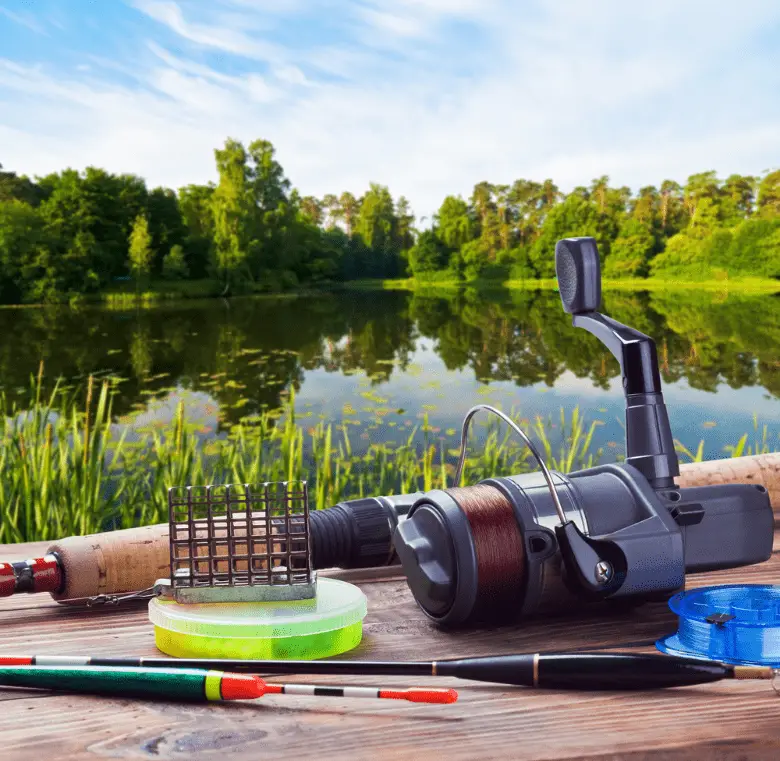
Here is a list of basic terminal tackle requirements. You will no doubt find most of this already in your kit.
It is all relatively inexpensive anyway, and you will not need a lot of it. We’ll move on to rigs and lures later under dedicated titles.
1. Sinkers. Bullets, balls, and split-shot
Weight can spook a trout, causing it to drop a bait. You are only ever going to want enough led to get the bait where you want it.
Land-based anglers may need a little more for casting purposes, but the rule of thumb is – use as little as you possibly can – like…tiny.
2. Hooks
Choose number 4 to number 6 bait-holder or circle hooks. I return a lot of fish to the water, so I find the circle hooks, while more expensive, are a better hook for inflicting less harm on the fish.
Hint. Don’t skimp on hooks. Spend the coin and get light gauge, yet strong, chemically sharpened hooks.
I’m not brand loyal here, there are so many good ones available that I go for anything that is a good deal.
3. Swivels
Match swivel size to the test weight of your line. Again, small as you can go. Lots of anglers get fussy with swivel styles and colors – I don’t. I’ll use what I have, usually a standard barrel.
I don’t like to use swivels that are too big for the line class. I’m not sure if using a larger swivel really creates any issues – if nothing else, it looks unbalanced, and certainly doesn’t enhance stealth.
4. Leader
Fluro? Mono? It’s up to you. I spool and fish with mono when I chase trout. I like it.
There is something gentle about lightweight mono that suits the lake and dam trout hunt. Not very scientific, maybe, but it’s certainly easy.
So, if I need a leader, I make my leader from the main line – it doesn’t get easier than that.
Importantly, in my experience, light leaders work better and I strongly recommend it.
If you are fishing braids, I create a leader the same test weight as my main line. Fluro or mono, either is great.
The only exception to fishing mono main line is when I troll. I find braid visibility gives me a better gauge of depth.
5. Floats
A simple bobbing float is all you will need. I always carry a selection but I have often used a cork. Size is tricky, carry a selection.
Ideally, I want to go as small as I can to eliminate resistance for the bite and also to eliminate the impact of the wind.
Your baits will be small so it will be unlikely you will sink it. A live bait might force you to size up a little.
For me, there are times when I can’t see a really small float…(my old age), so I size up a little purely to see it.
6. Downriggers
OK, clearly a downrigger doesn’t fall under the terminal tackle category. However, I have managed to terminate a few of them in my time.
If you intend to troll a deeper lake, a downrigger is pretty well essential.
If you do your research before you get to a particular location, you will have learned if that particular body of water delivers when trolling the depths.
The only qualification I put on the whole deep trolling thing, is that it is starting to get away from simplicity unless you have some experience with downriggers.
I had to mention it because it can be a very successful method and not that complicated for an angler with a little trolling nous.
Keep in mind that a decent downrigger can be a little pricey if you’re on a budget.
Trout Baits 101
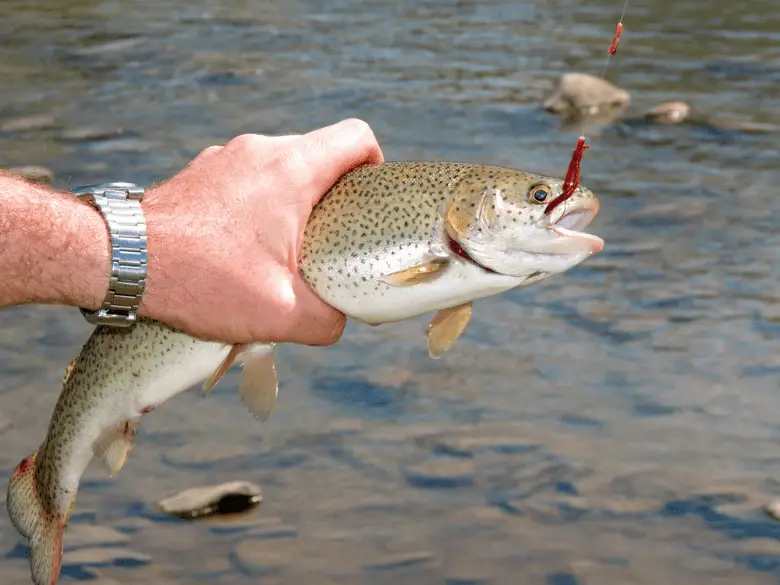
Selecting baits for trout can be a very local affair. It’s wise to take some advice before you hit the water.
However, there are some great standards that will produce excellent results just about anywhere and anytime of the year.
This is where we will focus. My aim here is that you don’t have to go to any real trouble. I’ll select the baits that the kids can use happily.
These baits will catch you plenty of fish as well.
1. Garden Worms
It doesn’t get better than this. Use them live all year round anywhere. If you don’t get some serious action on garden worms, there aren’t any fish there.
2. Crickets and Grasshoppers
These guys are brilliant in the summer months and easily rigged and fished. Ideal on the surface they will even produce once dead and weighted below the surface.
Cockroaches are also highly effective, however, there are many anglers that would prefer other options for obvious reasons.
3. Dough Baits
You can make these at home with simple ingredients from the kitchen. There are many recipes with many of them being highly effective all year round and they’re extremely cheap to make.
Common ingredients include flower, garlic, cheese and oats. My special mix includes a frankfurt.
Check online for the multitude of recipes with step by step instructions. I love these baits for the kids because you can get them to help you make them.
It’s very easy for the kids to bait up and it’s the most inoffensive fishing bait you could ever hope for.
Most importantly, they cost hardly anything to make and are incredibly effective for catching trout all year round from anywhere.
I’m a huge fan of dough baits and will never go trout fishing without a batch.
4. PowerBait Trout Nuggets
These artificial baits have been a revelation for fuss-free bait fishing for trout. In my opinion, they have been responsible for more people becoming involved in trout fishing.
I have read reviews from people who have been disappointed, however, the vast majority of reviews confirm their effectiveness.
Indeed, they are that easy and so effective they have a price tag to match. These little gems are expensive, and they need to be stored correctly to ensure they last.
If I’m going fishing for trout, I take a jar of them. Why? Because they work.
Lures for Trout Fishing
The discussion about trout lures can go on forever. Often the issue gets highly subjective, anecdotal, with little ‘science’ included in the discussion.
For what it’s worth, I’ll tell you my approach. I listen to the locals and get their perspective, then, I use whatever I have in my tackle box.
This includes vibes, cranks, sinkers, floaters, stick baits, poppers, frog profiles, minnows, big bibs, no bibs…soft plastics, hard body, spinners, hybrids, and metal slices.
Are you getting the drift here? I’ve caught trout on nearly every lure in my kit. The only thing that I’m really focused on is the size.
Anything around the 50 to 60mm mark is where I begin. I guess my rule of thumb is that reasonably small lures can catch really big trout.
It is true that there are certain colors, types, and techniques that will work better than others but this is very local and specific to the area.
Lures for trout is not an exact science. With size decided, I consider where I want to work it in the water column, and off I go.
I would like to tell you the definitive trout lure, but there’s no such thing.
The best advice I can give is to ask the locals. It’s their insights that will help you with colors, types and sizes. Short of that, take a punt.
Trout will eat trout. So any trout profile lure you have is an excellent start.
Rigs for Trout fishing
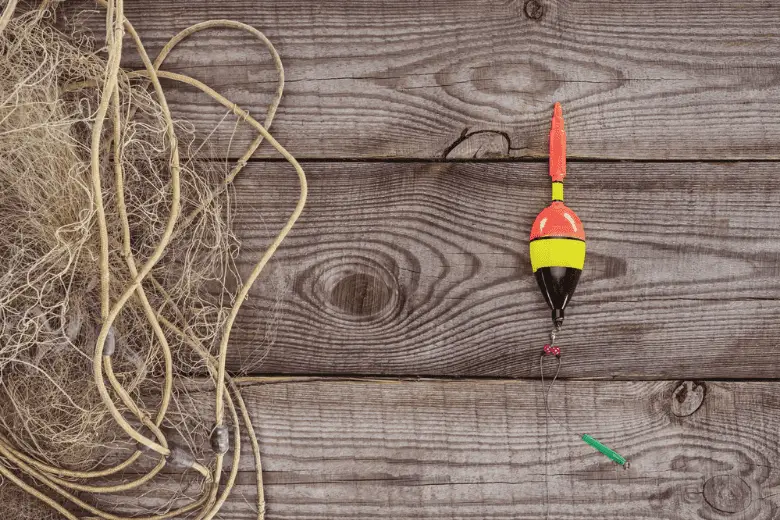
This is one of the reasons I love trout fishing so much. The rigs I use are dead simple and every one of them are effective.
Your rig decision will be determined primarily by conditions – wind, water depth, weather, and water temperature, are you land-based or floating.
Of course, the choice of baits or lures is the biggest rig factor. However, whichever way you go, simplicity is the order of the day. This is great news knowing that trout are notoriously difficult to catch.
Here’s a list of successful trout fishing rigs I use whenever I fish the elusive trout.
1. Floating Baits
A grasshopper or cricket on a hook floated on an eddy or cast to a bank is awesome.
It’s a size 6 hook and the bait.
There’s nothing simpler and the rewards can be amazing. Try some Powerbait on the same rig for similar results.
The warmer months are the best for this, but it will work during the winter depending on your location.
2. Float Fishing
If I have the option of fishing two lines, I will often throw out a worm under a float while I cast a few lures.
A split shot on top of a number 6 hook, tied to the bobbing float will often yield great results all year round.
Experiment with your leader length. I use a minimum of a foot up to two foot of leader. Powerbait is great here too, just remember it floats, so weight accordingly.
To be honest, float fishing is something I like to do when I’m alone, want to chill outfocusing only on the movement (potential movement) of my float.
There’s something old-school and nursery rhyme about this type of fishing. I love it.
What’s more, I’ve caught plenty of fish from the middle of the biggest lake to the smallest of ponds.
3. The Classic Rig
A number 4 to 6 circle hook tied to a leader with a tiny sinker above a swivel. This classic rig will be nigh on perfect just about everywhere, any time of the year.
A ball or bullet sinker is fine, as light as possible.
Pond, lake or impoundment, boat, land-based or kayak, this is a stocked trout staple and most likely responsible for most of my trout catches in lake and pond environments.
Use worms, dough baits, Powerbait or whatever you have selected to entice your target.
If I’m not using lures, I think I prefer this rig above all others for consistent results all year round. Use a running sinker to keep your bait off the bottom.
4. Trolling
If you are fortunate enough to own a boat, trolling lures for trout is highly productive.
My preferred method is to run a lure two to 10 feet below the surface, depending on my proximity to the bank.
Working along the banks has provided me with the most consistent results. However, there are certain times of the year where I’ll hit the deeper parts of a lake with the deepest running lure I have.
I usually do this if it’s a really hot day. Insects collecting on the surface of deeper sections of a body of water is often my cue.
However, I’ll do it on a whim if I’m getting no results on the banks and getting impatient.
If I’m resorting to a downrigger, this means I’m getting kind of desperate. It’s a little outside my preference for simplicity.
5. Casting Lures
Casting lures toward the banks and structure is probably my favorite. I prefer hard body lures, but that’s a personal preference.
Even if I am told that soft plastics are successful in the area I’ll start with a crank or a minnow anyway. This is just me, but it’s worked pretty well.
My best tip. Use a spinner if nothing else is working. The amount of times this has yielded results makes me feel as though I’m crazy for not clipping on a Mepps from the get-go.
If you’re not set in your ways, like me, cast a Mepps first up. To be honest, I’m astonished at the size of fish these small lures will attract and how consistent they are.
Just remember, chasing trout with lures is not much different to chasing any other fish with lures.
Find structure. Locate the places where predatory fish will lay in wait. Trout love cover and they love a lure to come past their lair. Cast at it.
A Couple of Great Trout Tips
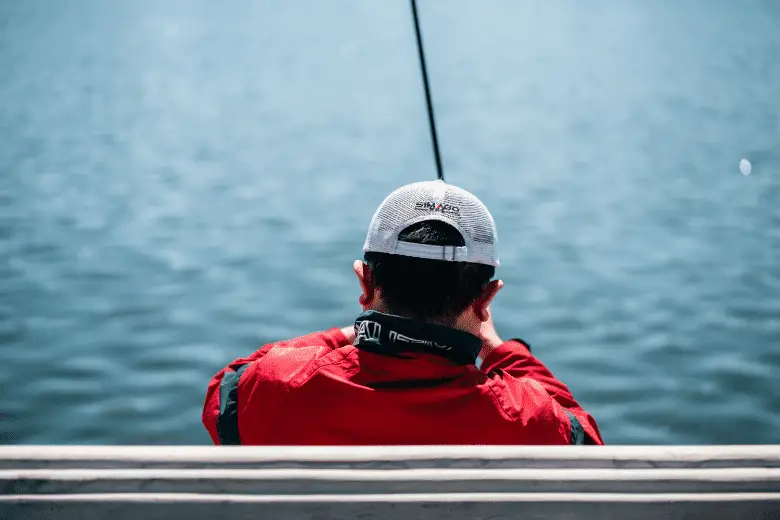
1. Don’t Change Location too soon
I have caught trout in places that defy logic. Boring structureless places that common sense would tell you hold nothing but empty water.
Thing is, if there’s one trout there, there is another. If you get a fish, work the spot and keep working it. There’s another one there.
Change tactics before you change location if you’re not getting a further look-in.
2. Persist when catching trout
Persist. Trout can be funny creatures and frustratingly elusive. Fish as light as you can and use your basic fishing sense.
Despite some unique peculiarities, fishing for trout is like fishing for any other fish. Think about it, yes. But don’t overthink it.
Keeping things simple and solid fishing basics is the fastest path to consistent trout success.
Also Read: How To Ice Fish For Rainbow Trout
Conclusion
Trout fishing really is for everybody. Perhaps the greatest barrier is that you may not live near a lake, river or stream that holds stock trout…or native trout, for that matter.
If that is the case then here’s my suggestion. Make an effort and go out of your way to find a trout.
The mystique of trout fishing is real, and you won’t understand it until you’ve had a go at hunting one.
As a dyed in the wool saltwater angler, I caught my first trout well into my life’s fishing journey, and I’ll never forget it.
Trout fishing is a very special part of our sport, it’s for everybody, and it’s for you too. Practice your trout fishing tips today
Sharing is caring!
